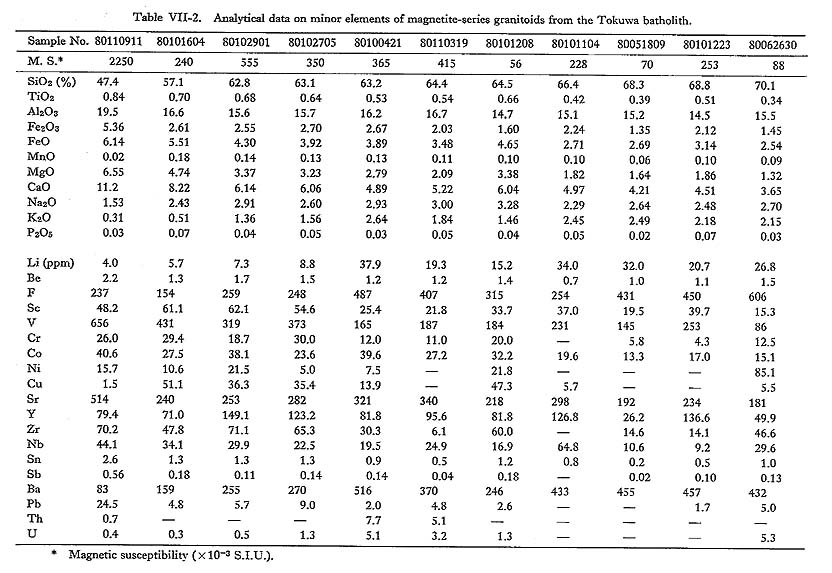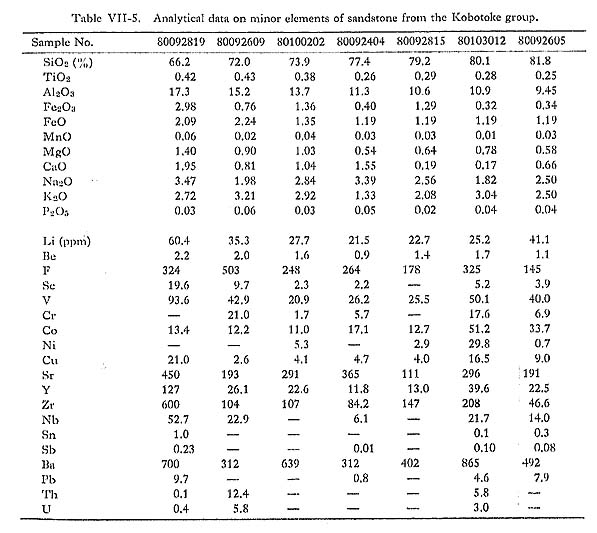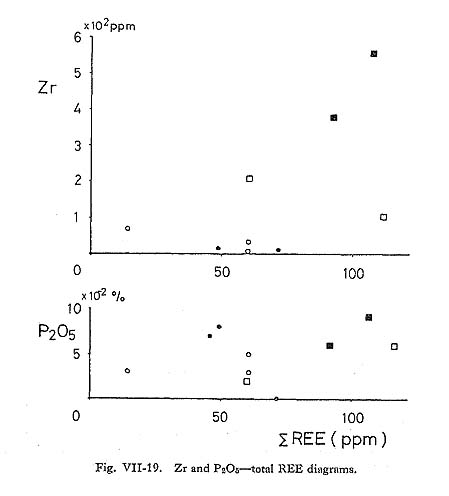CHAPTER VII
Whole-Rock Chemistry
3) Rare Earth Elements
|
Rare earth elements (REE) and some of the minor elements in ten samples from the Tokuwa batholith and the Kobotoke Group were determined using a neutron activation analytical instrument, mainly following the chemical procedure of Y. Masuda et al. (1974) (Table VII-6). Analytical precision is estimated to be better than 10% of the measured values. The sample locations are shown in Fig. VII-16.
Data were normalized to the average chondrite data of A. Masuda et al. (1973) and A. Masuda (1975). The normalized REE data on the Tokuwa batholith rocks are plotted in Fig. VII-17, and show the following features: (1) The REE patterns of the granitoids are moderately differentiated, whereas the REE pattern of hornblende gabbro is relatively linear and less differentiated than granitoids. All the granitoids are enriched in light REE: the chondrite-normalized Ce concentration ([Ce]N) is 27 to 43, whereas [Yb]N is 11 to 15. The ratio [Ce]N/[Yb]N ranges from 2.3 to 3.8. Hornblende gabbro ([Ce]N=7.2, [Yb]N=6.8, [Ce]N/[Yb]N=1.1) has a low REE content and a distinct positive Eu anomaly (Eu/Eu*=1.4, Eu* denotes Eu content derived by linear interpolation between Sm and Gd), which is probably reflected by plagioclase accumulation (Drake, 1975). This corresponds to the high Sr, Ca, and Al and low incompatible element contents in the rock. (2) All the granitoids have Eu anomalies with Eu/Eu* of 0.69 to 0.87 for rocks with 63 to 65% SiO2 contents. The values of Eu/Eu* of ilmenite-series granodiorite (0.79 to 0.87) are slightly higher than those of magnetite-series granodiorite (0.73 to 0.81). Eu/Eu* ratios of the two series of rocks probably have a positive correlation with the Al2O3 contents of the rocks. (3) Ilmenite-series granodiorite has higher [Ce]N/[Yb]N ratios (mean 11.5) than magnetite-series granodiorite (mean 9.4). [Ce]N/[Yb]N ratios as well as the degree of the negative Eu anomaly tend to increase as a function of the increase in SiO2 and K2O contents (Fig. VII-18).
The overall REE abundances and the patterns of the Tokuwa batholith rocks are similar to those for present lower crust reported by Taylor (1979) and those for the San'in granitoids reported by Y. Masuda et al. (1979). Fourcade and Allègre (1981) mentioned that the distribution of REE and other minor elements ainong coexisting minerals is essentially determined by accessory phases. Lyakhovich (1967) noted that REE in granitoids are concentrated in sphene, apatite, allanite, epidote, zircon, monazite, and xenotimc. It is worth mentioning that the modal concentrations of apatite and zircon are low in the Tokuwa batholith rocks as inferred from the P2O5 (0.00 to 0.09%) and Zr (12 to 70 ppm) contents (see Tables VII-2 to VII-6 and Fig. VII-19). It is hence considered that apatite and zircon, at least, do not play a major role in determining these observed patterns, even if large partition coefficients are expected (Nagasawa, 1970). Sphene, monazite, and allanite which are occasionally included in biotite, alkali feldspar, and quartz can be attributed to the light REE-enriched patterns of magnetite-series and ilmenite-series granitoids from the Tokuwa batholith.
Shale and sandstone of the Kobotoke Group are also enriched in light REE, with [Ce]N of 35 to 66, [Yb]N of 7.6 to 14, and [Ce]N/[Yb]N of 4.6 to 5.6. Some of these samples have significantly negative Eu anomalies. The REE patterns of the Kobotoke Group sedimentary rocks are very similar to those of the present upper crust reported by Taylor (1979). Because the degree of negative Eu anomaly in ilmenite-series granitoids is higher than in magnetite-series granitoids, the REE evidence probably indicates the affinity between sedimentary rocks and ilmenite-series granitoids. |








